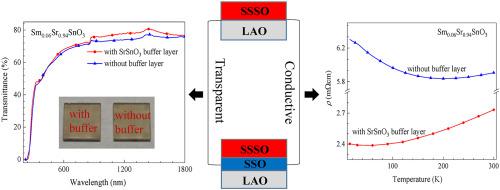当前位置:
X-MOL 学术
›
Opt. Mater.
›
论文详情
Our official English website, www.x-mol.net, welcomes your
feedback! (Note: you will need to create a separate account there.)
Transparent and conductive Sm-doped SrSnO3 epitaxial films
Optical Materials ( IF 3.8 ) Pub Date : 2020-09-01 , DOI: 10.1016/j.optmat.2020.110139 Kaifeng Li , Qiang Gao , Li Zhao , Qinzhuang Liu
Optical Materials ( IF 3.8 ) Pub Date : 2020-09-01 , DOI: 10.1016/j.optmat.2020.110139 Kaifeng Li , Qiang Gao , Li Zhao , Qinzhuang Liu

|
Abstract Perovskite-structured (SmxSr1-x)SnO3 (SSSO) films with x = 0–0.15 were epitaxially grown on LaAlO3(001) substrates by pulsed laser deposition, and the microstructure, transport and optical properties were investigated in detail. X-ray diffraction results show that the lattice constants gradually decrease with the Sm content increasing. Atomic force microscopy images confirm that all the films possess a smooth surface with low surface roughness. X-ray photoelectron spectroscopy measurements prove the existence of Sm3+ state in the doped SSSO films. Hall-effect measurements show that the film at x = 0.06 has the lowest room-temperature resistivity of 5.91 mΩcm and the highest electron mobility of 14.8 cm2/Vs. Temperature-dependent resistivity curves were fitted and explained by weak localization effect and e--e- interactions at low temperatures for films at x = 0.04 to 0.10. Optical transparency of all the films is more than 70% in the wavelength range from 600 to 1800 nm, and the band gaps increase gradually from 4.27 to 4.60 eV with increasing Sm content to 0.06, which can be ascribed to Burstein-Moss effect. Furthermore, the insertion of pure SrSnO3 buffer layer between the substrate and the SSSO film considerably reduces the density of dislocations, thereby leading to the improved electrical transport property. All these results bring rare-earth element Sm a step closer to optoelectronic applications of all-perovskite transparent and conductive oxides.
中文翻译:

透明导电的 Sm 掺杂 SrSnO3 外延薄膜
摘要 通过脉冲激光沉积在 LaAlO3(001) 衬底上外延生长 x = 0-0.15 的钙钛矿结构 (SmxSr1-x)SnO3 (SSSO) 薄膜,并详细研究了其微观结构、传输和光学性能。X射线衍射结果表明,随着Sm含量的增加,晶格常数逐渐减小。原子力显微镜图像证实所有薄膜都具有光滑的表面和低表面粗糙度。X 射线光电子能谱测量证明掺杂 SSSO 薄膜中存在 Sm3+ 状态。霍尔效应测量表明,x = 0.06 处的薄膜具有 5.91 mΩcm 的最低室温电阻率和 14.8 cm2/Vs 的最高电子迁移率。温度相关的电阻率曲线被拟合并通过低温下 x = 0.04 至 0.10 的薄膜的弱定位效应和 e-e- 相互作用来解释。所有薄膜在600~1800 nm波长范围内的透光率均超过70%,随着Sm含量增加到0.06,带隙从4.27到4.60 eV逐渐增加,这可以归因于Burstein-Moss效应。此外,在衬底和 SSSO 膜之间插入纯 SrSnO3 缓冲层大大降低了位错密度,从而提高了电传输性能。所有这些结果使稀土元素 Sm 更接近于全钙钛矿透明导电氧化物的光电应用。所有薄膜在600~1800 nm波长范围内的透光率均超过70%,随着Sm含量增加到0.06,带隙从4.27到4.60 eV逐渐增加,这可以归因于Burstein-Moss效应。此外,在衬底和 SSSO 膜之间插入纯 SrSnO3 缓冲层大大降低了位错密度,从而提高了电传输性能。所有这些结果使稀土元素 Sm 更接近于全钙钛矿透明导电氧化物的光电应用。所有薄膜在600~1800 nm波长范围内的透光率均超过70%,随着Sm含量增加到0.06,带隙从4.27到4.60 eV逐渐增加,这可以归因于Burstein-Moss效应。此外,在衬底和 SSSO 膜之间插入纯 SrSnO3 缓冲层大大降低了位错密度,从而提高了电传输性能。所有这些结果使稀土元素 Sm 更接近于全钙钛矿透明导电氧化物的光电应用。在衬底和 SSSO 膜之间插入纯 SrSnO3 缓冲层大大降低了位错密度,从而提高了电传输性能。所有这些结果使稀土元素 Sm 更接近于全钙钛矿透明导电氧化物的光电应用。在衬底和 SSSO 膜之间插入纯 SrSnO3 缓冲层大大降低了位错密度,从而提高了电传输性能。所有这些结果使稀土元素 Sm 更接近于全钙钛矿透明导电氧化物的光电应用。
更新日期:2020-09-01
中文翻译:

透明导电的 Sm 掺杂 SrSnO3 外延薄膜
摘要 通过脉冲激光沉积在 LaAlO3(001) 衬底上外延生长 x = 0-0.15 的钙钛矿结构 (SmxSr1-x)SnO3 (SSSO) 薄膜,并详细研究了其微观结构、传输和光学性能。X射线衍射结果表明,随着Sm含量的增加,晶格常数逐渐减小。原子力显微镜图像证实所有薄膜都具有光滑的表面和低表面粗糙度。X 射线光电子能谱测量证明掺杂 SSSO 薄膜中存在 Sm3+ 状态。霍尔效应测量表明,x = 0.06 处的薄膜具有 5.91 mΩcm 的最低室温电阻率和 14.8 cm2/Vs 的最高电子迁移率。温度相关的电阻率曲线被拟合并通过低温下 x = 0.04 至 0.10 的薄膜的弱定位效应和 e-e- 相互作用来解释。所有薄膜在600~1800 nm波长范围内的透光率均超过70%,随着Sm含量增加到0.06,带隙从4.27到4.60 eV逐渐增加,这可以归因于Burstein-Moss效应。此外,在衬底和 SSSO 膜之间插入纯 SrSnO3 缓冲层大大降低了位错密度,从而提高了电传输性能。所有这些结果使稀土元素 Sm 更接近于全钙钛矿透明导电氧化物的光电应用。所有薄膜在600~1800 nm波长范围内的透光率均超过70%,随着Sm含量增加到0.06,带隙从4.27到4.60 eV逐渐增加,这可以归因于Burstein-Moss效应。此外,在衬底和 SSSO 膜之间插入纯 SrSnO3 缓冲层大大降低了位错密度,从而提高了电传输性能。所有这些结果使稀土元素 Sm 更接近于全钙钛矿透明导电氧化物的光电应用。所有薄膜在600~1800 nm波长范围内的透光率均超过70%,随着Sm含量增加到0.06,带隙从4.27到4.60 eV逐渐增加,这可以归因于Burstein-Moss效应。此外,在衬底和 SSSO 膜之间插入纯 SrSnO3 缓冲层大大降低了位错密度,从而提高了电传输性能。所有这些结果使稀土元素 Sm 更接近于全钙钛矿透明导电氧化物的光电应用。在衬底和 SSSO 膜之间插入纯 SrSnO3 缓冲层大大降低了位错密度,从而提高了电传输性能。所有这些结果使稀土元素 Sm 更接近于全钙钛矿透明导电氧化物的光电应用。在衬底和 SSSO 膜之间插入纯 SrSnO3 缓冲层大大降低了位错密度,从而提高了电传输性能。所有这些结果使稀土元素 Sm 更接近于全钙钛矿透明导电氧化物的光电应用。











































 京公网安备 11010802027423号
京公网安备 11010802027423号